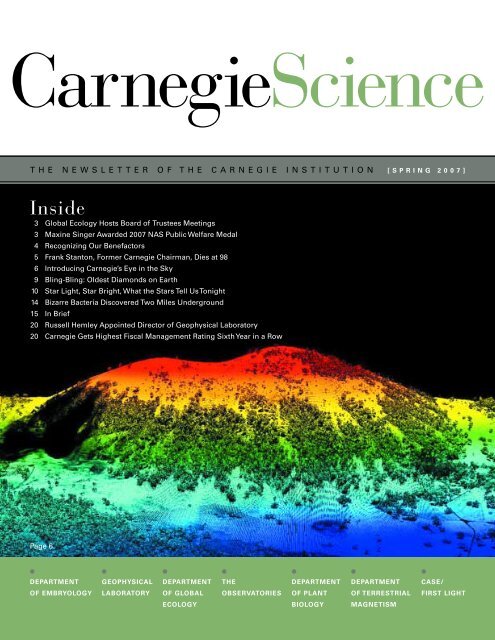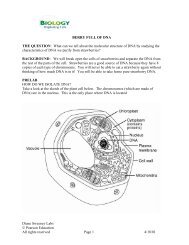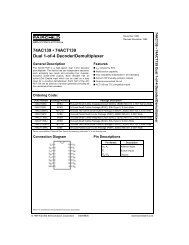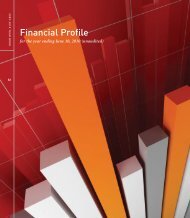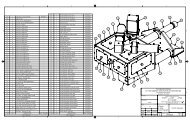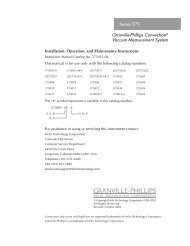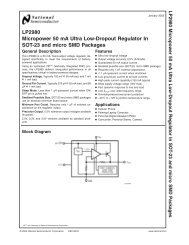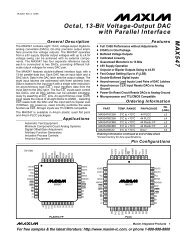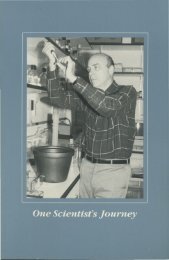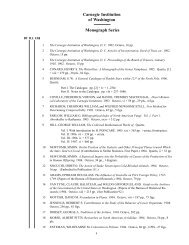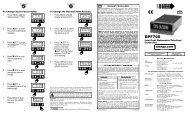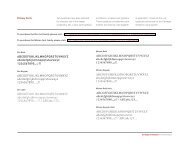PDF (900KB) - Carnegie Institution for Science
PDF (900KB) - Carnegie Institution for Science
PDF (900KB) - Carnegie Institution for Science
- No tags were found...
You also want an ePaper? Increase the reach of your titles
YUMPU automatically turns print PDFs into web optimized ePapers that Google loves.
<strong>Carnegie</strong><strong>Science</strong>THE NEWSLETTER OF THE CARNEGIE INSTITUTION [SPRING 2007]Inside3 Global Ecology Hosts Board of Trustees Meetings3 Maxine Singer Awarded 2007 NAS Public Welfare Medal4 Recognizing Our Benefactors5 Frank Stanton, Former <strong>Carnegie</strong> Chairman, Dies at 986 Introducing <strong>Carnegie</strong>’s Eye in the Sky9 Bling-Bling: Oldest Diamonds on Earth10 Star Light, Star Bright, What the Stars Tell Us Tonight14 Bizarre Bacteria Discovered Two Miles Underground15 In Brief20 Russell Hemley Appointed Director of Geophysical Laboratory20 <strong>Carnegie</strong> Gets Highest Fiscal Management Rating Sixth Year in a RowPage 6DEPARTMENTGEOPHYSICALDEPARTMENTTHEDEPARTMENTDEPARTMENTCASE/OF EMBRYOLOGYLABORATORYOF GLOBALOBSERVATORIESOF PLANTOF TERRESTRIALFIRST LIGHTECOLOGYBIOLOGYMAGNETISM
2CARNEGIEINSTITUTION FORSCIENCEPresidentRichard A. MeserveDirector,Department of EmbryologyAllan C. SpradlingDirector,Geophysical LaboratoryWesley T. Huntress, Jr.Director,Department of Global EcologyChristopher FieldDirector,The Observatories,Craw<strong>for</strong>d H. Greenewalt ChairWendy L. FreedmanDirector,Department of Plant BiologyChristopher SomervilleDirector,Department of Terrestrial MagnetismSean C. SolomonDirector,Administration and FinanceGary KowalczykChief In<strong>for</strong>mation OfficerGotthard Sághi-SzabóChief Advancement OfficerChristine D. SmithDirector,External AffairsSusanne GarveyEditorTina McDowell<strong>Science</strong> WriterMatthew E. Wright<strong>Carnegie</strong> <strong>Institution</strong> of Washington1530 P Street, NWWashington, D.C.20005 -1910202.387.6400www.<strong>Carnegie</strong><strong>Institution</strong>.orgThe <strong>Carnegie</strong> Campaign <strong>for</strong> <strong>Science</strong> concluded on December 31, 2006, having raised $60million and accomplishing critical objectives essential to the future of the institution. Althoughour endowment and related income are the primary funding sources <strong>for</strong> <strong>Carnegie</strong> science, generousorganizations, foundations, and individual benefactors are increasingly important to oursuccess in fulfilling our mission. The campaign allowed us to build two state-of-the-art buildingsand upgrade critical facilities, to purchase next-generation scientific instrumentation, to secureongoing support <strong>for</strong> new initiatives, and to embark on far-reaching future capital projects. I thankeveryone who contributed; <strong>Carnegie</strong> is much stronger because of your generosity.Those of us who have had the privilege of spending time in the two new buildings knowthat the <strong>Carnegie</strong> Campaign <strong>for</strong> <strong>Science</strong> provided facilities of the quality deserved by our scientists.The new building <strong>for</strong> the Department of Global Ecology was custom designed and built tomeet the needs of our newest department; moreover, it is the only fully “green” building on theStan<strong>for</strong>d campus. The dazzling and functional Maxine F. Singer Building, including the 105-seatRose Auditorium, will serve the scientists in that Nobel Prize-winning department <strong>for</strong> years tocome. Additionally, we completed renovations in the David Greenewalt Building on the campusshared by the Geophysical Laboratory (GL) and the Department of Terrestrial Magnetism (DTM),and we significantly upgraded the headquarters <strong>for</strong> the Observatories in Pasadena.Advanced instrumentation is critical to our scientific program. The <strong>Carnegie</strong> Campaign <strong>for</strong><strong>Science</strong> enabled the acquisition of instruments of critical importance to the work of our scientists.●●●●Researchers at DTM now have the use of a NanoSIMS ion probe, which has been vitalto the DTM/GL team studying the composition of dust grains from the comet Wild 2returned by the Stardust mission.The High Pressure Collaborative Access Team and the diamond group at GL were ableimprove their equipment, keeping them world leaders in unraveling the mysteries ofmatter under extreme conditions and developing new 21 st century materials.The Observatories developed instrumentation <strong>for</strong> the Magellan telescopes to addresssome of the most pressing questions in astronomy today. They also created newtechnology <strong>for</strong> correcting atmospheric aberrations at the ground level, which couldimprove telescopes’ per<strong>for</strong>mance around the world.The campaign contributed to a variety of projects at Global Ecology, including theone-of-a-kind <strong>Carnegie</strong> Airborne Observatory. With its sophisticated imaging and laserremote sensing technologies, researchers can study regional ecosystems anywherein the world to better understand land-use change, climate change, and the impactof natural disturbances on the structure and function of ecosystems.Progress was also made in growing our endowment. Endowed funds raised will maintainthe new buildings, support growth in the Department of Global Ecology, provide postdoctoralfellowship support, and underpin the general work of the institution. Endowments createdthrough the campaign, along with the extraordinary per<strong>for</strong>mance of our investments over thesix-year period of the campaign, put us in a strong financial position.Maintaining excellence is a never-ending task. As a result, we must continue to seekresources to provide the best support <strong>for</strong> the great scientists at <strong>Carnegie</strong>. If Andrew <strong>Carnegie</strong>were here today, he would be proud to see how like-minded contemporary friends of hisinstitution share his vision and support its future. Without their support in the past six yearsand on into the future, the <strong>Carnegie</strong> <strong>Institution</strong> could not maintain its world-class status.To our generous benefactors, I extend my heartfelt thanks.—Michael E.Gellert, Chairman
S P R I N G 2 0 0 7 3TrusteeNewsGlobal Ecology HostsBoard of Trustees MeetingsThe 125 th meeting of the <strong>Carnegie</strong> board of trustees took place inthe Department of Global Ecology’s state-of-the-art “green”building, on the campus shared with the Department of PlantBiology in Stan<strong>for</strong>d, Cali<strong>for</strong>nia. At its first session, on December7, the board unanimously elected its newest trustee, Remi Barbier. TheFinance, Development, and Research committees also met. Tours of theGlobal Ecology labs followed the meetings. Trustees, guests, and faculty fromboth departments gathered <strong>for</strong> dinner at which senior <strong>Carnegie</strong> trusteeand chairman of the Stan<strong>for</strong>d board of trustees Burton McMurtry was thefeatured speaker.The second session of the board took place on the following day,preceded by the meeting of the Nominating Committee. President RichardMeserve then reported on the state of the institution. Plant Biology staffmember Sue Rhee followed with a talk about her work developing anddirecting the popular biological database, TAIR (The Arabidopsis In<strong>for</strong>mationResource). She also described how the database is used in gene research.The meetings concluded with each director summarizing significant workat the departments.New Trustee Remi Barbier,Founder and CEO of Pain Therapeutics, Inc.The <strong>Carnegie</strong> board of trustees has elected RemiBarbier, president and CEO of Pain Therapeutics,Inc., to its board on December 7. Founded byBarbier in 1998, Pain Therapeutics is a publiclytraded (NASDAQ: PTIE) biotechnology companybased in South San Francisco, Cali<strong>for</strong>nia.“Remi Barbier brings an impressive array ofknowledge and experience from the science andbusiness communities to our board,” commented<strong>Carnegie</strong> president Richard Meserve. “He will be invaluable to the growth ofthe institution.”Pain Therapeutics develops novel drugs in the areas of pain managementand oncology. For more in<strong>for</strong>mation please visit the company’s Website, www.paintrials.com.A lifelong entrepreneur in the life sciences, Barbier has founded,cofounded, or helped grow several biomedical companies, including Exelixis,Inc., a leading genomics-based drug discovery company; ArQule, a chemistrycompany; and EnzyMed, a chemistry company now owned by AlbanyMolecular Research, Inc. Barbier obtained his undergraduate degree fromOberlin College and an MBA from the University of Chicago.Board of trustee members Suzanne Nora Johnson(left) and Steve Fodor tour the labs at Global Ecology.Global Ecology staff member Joe Berry describes a CO 2monitoring system, designed <strong>for</strong> remote regions, tobetter understand how the global carbon cycle works.Dr. Maxine F. SingerMaxine SingerAwarded 2007 NASPublic Welfare MedalThe National Academy of <strong>Science</strong>shas awarded <strong>Carnegie</strong> presidentemerita Maxine F. Singer the PublicWelfare Medal, the academy’smost prestigious honor, <strong>for</strong> her inspired leadershipin science and its application to educationand public policy. Each year the academyawards the medal to recognize the use of science<strong>for</strong> the public good.(Image courtesy Dan Singer.)Remi Barbier (above) was elected to the <strong>Carnegie</strong> board on December 7, 2006.
4 C A R N E G I E S C I E N C ERecognizingOur BenefactorsFounder of the<strong>Carnegie</strong> <strong>Institution</strong>,Andrew <strong>Carnegie</strong>In 1902, Andrew <strong>Carnegie</strong> pledged to support innovative researchers ofexceptional ability in an environment free from the constraints found inmost other research organizations. To this end, he created and endowedthe <strong>Carnegie</strong> <strong>Institution</strong>. <strong>Carnegie</strong> scientists are financed largely byendowment income and other revenues; the balance comes from generousindividuals and organizations who share the <strong>Carnegie</strong> vision.Philanthropic support <strong>for</strong> the <strong>Carnegie</strong> <strong>Institution</strong> allows our scientiststo pursue high-risk, high-reward research, which has put them at the <strong>for</strong>efrontof their fields. Our primary benefactors play a key role in strengthening<strong>Carnegie</strong>’s ability to fulfill its critical mission. Starting this year, individualswho donate $10,000 annually and those who have made significant cumulativedonations will be recognized as members of <strong>Carnegie</strong> PhilanthropicSocieties. These societies recognize individuals who have given at differentlevels. The Barbara McClintock Society shows appreciation <strong>for</strong> individualswho contribute $10,000 or more in a fiscal year. The <strong>Carnegie</strong> Founders,Edwin Hubble, and Vannevar Bush societies honor individuals who havemade lifetime contributions of $10 million, $1 million, and $100,000 respectively.Second Century Society members contribute to <strong>Carnegie</strong> throughplanned giving.<strong>Carnegie</strong> astronomerEdwin Hubble<strong>Carnegie</strong> scientistand Nobel laureateBarbara McClintockFormer <strong>Carnegie</strong>president and leaderof American scientificresearch Vannevar Bush
S P R I N G 2 0 0 7 5 The Barbara McClintock SocietyAn icon of <strong>Carnegie</strong> science, Barbara McClintock was a <strong>Carnegie</strong> plantbiologist from 1943 until her retirement. She was a giant in the fieldof maize genetics and received the 1983 Nobel Prize in Physiology orMedicine <strong>for</strong> her work on patterns of genetic inheritance. She wasalso the first woman to win an unshared Nobel Prize in that category.To sustain researchers like McClintock, annual contributions to the<strong>Carnegie</strong> <strong>Institution</strong> are essential. The McClintock Society thus recognizesgenerous individuals who contribute $10,000 or more in a fiscalyear, making it possible to pursue the highly original research <strong>for</strong>which <strong>Carnegie</strong> is known. The <strong>Carnegie</strong> Founders SocietyAndrew <strong>Carnegie</strong>, the founder of the <strong>Carnegie</strong> <strong>Institution</strong>, establishedit with a gift of $10 million. Although he ultimately gave a total of $22million to the institution, his initial $10 million gift represents a speciallevel of giving. In acknowledgment of the significance of thisinitial contribution, individuals who support <strong>Carnegie</strong>’s scientificmission with lifetime contributions of $10 million or more arerecognized as members of the <strong>Carnegie</strong> Founders Society. The Edwin Hubble SocietyThe most famous astronomer of the 20th century, Edwin Hubble,joined the <strong>Carnegie</strong> <strong>Institution</strong> in 1919. His observations shatteredour old concept of the universe. He proved that the universe is madeof collections of galaxies and is not just limited to our own MilkyWay; he also showed that the universe is expanding. This work redefinedcosmology. <strong>Science</strong> typically requires years of work be<strong>for</strong>e majordiscoveries like these can be made. The Edwin Hubble Society honorsthose whose lifetime support has enabled the institution to continuefostering such long-term, paradigm-changing research by recognizingthose who contribute between $1,000,000 and $9,999,999. The Vannevar Bush SocietyVannevar Bush, the renowned leader of American scientific researchof his time, served as <strong>Carnegie</strong>’s president from 1939 to 1955. Bush believedin the power of private organizations and wrote in 1950, “It wasAndrew <strong>Carnegie</strong>’s conviction that an institution which sought out theunusual scientist, and rendered it possible <strong>for</strong> him to create to the utmost,would be worth while [sic] . . .” He further said that “the scientistsof the institution ...seek to extend the horizons of man’s knowledgeof his environment and of himself, in the conviction that it is good <strong>for</strong>man to know.” The Vannevar Bush Society recognizes individuals whohave made lifetime contributions of between $100,000 and $999,999.Second Century SocietyThe <strong>Carnegie</strong> <strong>Institution</strong> is now in its second century of supportingscientific research and discovery. The Second Century Society recognizesindividuals who have remembered, or intend to remember, the<strong>Carnegie</strong> <strong>Institution</strong> in their estate plans and those who have supportedthe institution through other <strong>for</strong>ms of planned giving.Frank Stanton,Former <strong>Carnegie</strong>Chairman, Dies at 98 Frank Stanton, <strong>for</strong>mer chair ofthe <strong>Carnegie</strong> board of trusteesand an icon of 20 th century broadcastmedia, died on Sunday,December 24, 2006, at his homein Boston. He was 98.Best known <strong>for</strong> his tenureas president of the CBS networkfrom 1946 to 1971, Stanton served on the <strong>Carnegie</strong>board from 1963 to 1985. He was chairman of theboard from 1977 to 1979 and sat on several committees,including the Executive Committee (member,1968-1984; chair, 1974-1975) and the Audit Committee(chair, 1981-1984). After 22 years of active service,Stanton became a trustee emeritus in 1985.Stanton assumed the presidency of CBS in 1946,when William S. Paley stepped down to become chairmanof the board. Together, Stanton and Paley shapedthe network into the most influential and reputable ofthe mid-20 th century, largely by advocating <strong>for</strong> televisionas the medium of choice over radio. The network’strademark mix of arts, entertainment, andhard-hitting news earned it the nickname “the TiffanyNetwork” during Stanton’s term.Stanton was born March 20, 1908, in Muskegon,Michigan. He received a bachelor’s degree from OhioWesleyan University in 1930, where he studied zoologyand psychology. Graduate studies at Ohio State Universityearned him a master’s degree in 1932 and a doctoratein 1935, both in psychology. Within months ofreceiving his doctorate, he began work in the researchdepartment at CBS.In addition to his service to <strong>Carnegie</strong>, Stantonwas chair of the American Red Cross (1973-1979) andthe Rand Corporation (1961-1967), and the foundingchairman of the Center <strong>for</strong> Advanced Study in theBehavioral <strong>Science</strong>s in Stan<strong>for</strong>d, Cali<strong>for</strong>nia (1953-1971). He sat on the boards of many other organizations,including the Lincoln Center <strong>for</strong> the Per<strong>for</strong>mingArts, the Educational Broadcasting Corporation,and the Rockefeller Foundation.
6Introducing<strong>Carnegie</strong>’s(Image courtesy Greg Asner.)Asner lab researcher Matt Jones guidesthe <strong>Carnegie</strong> Airborne Observatory (CAO)along its flight path. While the pilots, seatedin front, actually steer the plane, Jones providesthem with precise, real-time directionsvia a heads-up display to ensure thatvaluable flight time is not wasted.The skies over Hawaii buzz with thepropellers of small aircraft. Most ofthem ferry people among the islands,or give tourists a glimpse ofinaccessible locales. But there is oneamong the swarm that is unlikeanything else in the sky, distinguishable from the tourist planesonly by a small opening underneath that bristles with lensesand sensors. This unassuming vessel will soon help researchersprobe deeper into the structure and chemistry of ecosystemsthan ever be<strong>for</strong>e.The <strong>Carnegie</strong> Airborne Observatory (CAO) wields someof the most powerful remote sensing instruments availabletoday. Conceived, developed, and brought to life by Greg Asnerand his team at the Department of Global Ecology, the CAO canefficiently image large swaths of <strong>for</strong>est in pinpoint three-dimensionaldetail. On a typical flight, the instruments gather gigabytesof data that can reveal patterns in native species diversity, <strong>for</strong>eignspecies invasion, <strong>for</strong>est growth rates, and overall ecosystemhealth. For the past several months, the Big Island of Hawaii—which contains examples of more than two-thirds of all ecosystemtypes on Earth—has served as the CAO’s proving ground.“It’s as if the in<strong>for</strong>mation is written in invisible ink, and allwe have to do is figure out how to read it,”Asner explains.“Whenwe fly overhead, we see the tops of trees. But the CAO can seephysical structures down below the canopy, and can pick up onbiochemical in<strong>for</strong>mation that is invisible to the naked eye.”A CAT Scanof the ForestThe heart of the CAO consists of two main instruments. One, awave<strong>for</strong>m light detection and ranging (LiDAR) system, mapsthe three-dimensional physical structure of the trees. LiDAR isa close cousin of radar, except that it bounces laser light off ofits targets instead of radio waves. The second device is a hyperspectralimager, which gathers in<strong>for</strong>mation about the biochemistryof the <strong>for</strong>est by measuring the wavelengths of lightreflected by trees and other vegetation. The CAO integrates theLiDAR and hyperspectral data on the fly to construct a completethree-dimensional picture.“Greg’s team is using the CAO to gather and blend incrediblydetailed physical and chemical data in a way that hasn’t beendone be<strong>for</strong>e,” says Global Ecology department director ChrisField. “They’ve essentially devised a way to do a virtual ‘CATscan’ of an ecosystem.”Strictly speaking, the plane itself is not part of the CAO;rather, the instruments are portable and designed to plug intojust about any small aircraft. This will enable Asner’s team todeploy the CAO anywhere in the world. It also allows razorsharpscanning that other remote sensing equipment, much ofwhich rides on satellites or in high-altitude aircraft, cannotequal. Depending on how low the plane flies, resolution canrange from 1 meter per pixel to as fine as 20 centimeters perpixel—precise enough to make out the individual branches andleaves on trees.
S P R I N G 2 0 0 7 7Eye in the Sky“It’s as if the in<strong>for</strong>mation is written in invisible ink,and all we have to do is figure out how to read it.”Diagnosis:Threatened EcosystemMuch as a doctor can use a CAT scan to detect and diagnose myriadailments in the human body, the CAO is designed to ferret outa variety of ecological threats. A crucial issue is the rampant thinning—andin some cases, disappearance—of native plant species.Asner plans to use the CAO to map the species diversityof rain <strong>for</strong>est ecosystems and discover which species are disappearing,and how quickly. Similarly, his team wants to knowwhere they are surviving, and what factors are vital <strong>for</strong> theirhealth. This in<strong>for</strong>mation can aid conservation ef<strong>for</strong>ts in Hawaii,the Brazilian Amazon, northern Australia, and elsewhere byidentifying the most threatened areas, as well as diversity “hotspots” where many species beat the odds and persevere.In many areas, the biggest threat is from <strong>for</strong>eign,“invasive”species that outcompete the natives <strong>for</strong> space and resources. Inthe Hawaiian test sites, <strong>for</strong> example, two particular introducedtree species can get their nitrogen from the air rather than fromthe limited supplies in the ground, as the native species do. Thishas allowed the faster-growing invaders to push out the nativesat an alarming rate. Using the CAO, Asner’s group can map andtrack these species, gathering data that can be used to in<strong>for</strong>mthe ef<strong>for</strong>t to stem the invasion.“The CAO has an unparalleled ability to measure andmap the structure, composition, and physiology of ecosystems,”says Flint Hughes, an invasive species ecologist and Asner’scollaborator from the U.S. Forest Service’s Institute of PacificIslands Forestry. “The conservation and management potentialis unique in Hawaii—and in the world, <strong>for</strong> that matter.”(Image courtesy Greg Asner.) (Image courtesy Greg Asner.)While this image might look like a screen capture from thepopular computer game SimCity, it is actually a live imageof a neighborhood in Hilo, Hawaii, taken by the CAO.This three-dimensional CAO LiDAR image of the Pu’u Wa’awa’a cinder cone, avolcanic feature on the Big Island of Hawaii, holds detailed in<strong>for</strong>mation aboutthe structure of the vegetation on its slopes. The color coding indicates altitude.
8 C A R N E G I E S C I E N C E(Images courtesy Greg Asner.)The same square of <strong>for</strong>est looks very different to the two “eyes” of the CAO. On the left, the Light Detection and Ranging (LiDAR) system revealsthe three-dimensional structure of the <strong>for</strong>est canopy; on the right, the hyperspectral imager highlights differences in chemical composition.(Images courtesy Greg Asner.)When hyperspectral and LiDAR data from the CAO are combined, stunning three-dimensional imagery like this is the result. Packed with hundredsof megabytes of data, a single image can reveal in<strong>for</strong>mation about the health and diversity of an ecosystem with an unprecedented level of detail.At left, a natural color composite shows a dense rain <strong>for</strong>est area in Hawaii. At right, chemical detection in the same area reveals canopies withhigh nitrogen content (yellow-white) contrasting with low nitrogen content (blue-red).Identification, PleaseAsner’s group will need a way to definitively identify plantspecies from the air in order to study species diversity and patternsof invasion. In theory, each species should have its ownunique fingerprint based on the chemicals in its leaves andstems, which will reflect slightly different wavelengths of light.To develop a key to these fingerprints, Asner’s team is collectingleaf samples the old-fashioned way—on foot—andmatching each species and their biochemistry with the spectraof light they reflect. With this in<strong>for</strong>mation in hand, it is testingthe CAO’s ability to accurately detect plant fingerprints fromthe air. As it refines the system, the team hopes to eventually beable to identify all the tree species in a study area with justone pass.While the CAO specializes in vegetation, it can also identifyhidden geomorphologic features in the landscape. Asner’scolleague and frequent collaborator, Stan<strong>for</strong>d ecologist PeterVitousek, recently looked at a CAO scan and could scarcely believehis eyes. There, in the middle of a study site he had traversedon foot literally hundreds of times, he saw that a series ofdepressions—water catchments and channels on the <strong>for</strong>estfloor—was organized in a way that he had never seen as awhole. “The CAO has the advantage of aerial access and largeareacoverage, but also provides levels of detail beyond whatyou can achieve on foot,” Vitousek says. “It’s going to prove incrediblyuseful in the study of fragile ecosystems, and learningmore about how they respond to conservation ef<strong>for</strong>ts.”— MATTHEW EARLY WRIGHTThe CAO hardware was funded by a grant from the W. M. Keck Foundation and a gift from William Hearst III.Scientific studies currently under way in Hawaii are funded by NASA, the U.S. Forest Service, and the State of Hawaii.
S P R I N G 2 0 0 7 9Bling-Bling: Oldest Diamonds on EarthScientists have dated diamonds from the recently discovereddiamond fields in Canada’s Northwest Territories<strong>for</strong> the first time and have found that they are theoldest precisely dated diamonds on Earth. They <strong>for</strong>med3.5 billion years ago in the Archean era, when the Earth was <strong>for</strong>mingits first continents.The researchers, Steven Shirey and Richard Carlson from<strong>Carnegie</strong>’s Department of Terrestrial Magnetism, with colleagues,also report evidence indicating that the diamonds probably<strong>for</strong>med during subduction—a process in which one crustal platesinks and slides under another hundreds of miles into Earth’smantle. The findings were published in the September 2006 issueof Contributions to Mineralogy and Petrology.(Image courtesy J.W. Harris.)Department of TerrestrialMagnetism scientistSteve ShireyThis photomicrograph is an example of a sulfide-inclusion-bearing roughdiamond. It is from the Jwaneng Mine in Botswana. The hexagonal grainat center is iron sulfide (Fe-S) surrounded by an irregular black rim. Sulfidegrains like these are removed <strong>for</strong> rhenium-osmium isotopic analysisto reveal the age of the diamond and the composition of the sulfide.Diamonds in the RoughDiamonds are dense <strong>for</strong>ms of carbon and the hardest naturalsubstance known. The largest diamonds come from cratons—ancientcontinental regions with deep roots providing a nucleusaround which younger continental material gathered. Cratonscontain the oldest rocks on the planet and hold much of theEarth’s mineral wealth, including diamonds. The roots extendinto the mantle more than 125 miles (200 km) deep where pressureis high enough, but temperature cold enough, <strong>for</strong> diamond<strong>for</strong>mation. The mantle “keels” to cratons are as old as the overlyingcrust and date from 3.9 to 2.5 billion years ago. Diamondscome to the surface from rare volcanic eruptions of magmas thatsolidify into rocks called kimberlites.Time Capsules from Ancient Earth“Diamonds aren’t just <strong>for</strong> spectacular jewelry,” said Shirey. “Theyare scientific gems too. They act as tiny time capsules. Many diamondsencase tiny mineral grains—what jewelers call impuritiesbut geoscientists call inclusions—that can tell us how old thediamond is and what geologic processes occurred in the deepEarth billions of years ago.”There are two major diamond varieties, eclogitic and peridotitic.For some time, scientists have believed that eclogitic diamonds<strong>for</strong>m from the process of subduction. But this studycontains the first evidence that peridotitic diamonds also may be<strong>for</strong>med from the water and other fluids released by subductingcrustal plates at depth.The researchers extracted sulfide inclusions from a sampleof diamonds, each about 1 carat, from Canada’s Slave Craton’sPanda kimberlite. They determined their age with the rheniumosmium(Re-Os) dating technique. Rhenium and osmium arenatural radioactive isotopes that decay at a predictable rate andmake good atomic clocks <strong>for</strong> determining absolute ages. Dependingon the chemical composition of the sulfides, scientists candetermine whether melt percolation, crustal recycling, or fluidaddition contributed to sulfide <strong>for</strong>mation. They can also determinethe temperature history of the minerals by looking athow nitrogen is distributed within the lattice structure of thediamonds—nitrogen atoms tend to pair up, or aggregate, morewith increasing temperatures.“We found that the diamonds are 3.5 billion years old andthat they resided at relatively low temperatures <strong>for</strong> billions ofyears,” said Shirey. The isotopic signature also indicates that subductionmay have been at work. “The evidence suggests that thisis one of the oldest subduction events found and that subductionis a way to <strong>for</strong>m the earliest continents.”
10 C A R N E G I E S C I E N C EStar Light,Star Bright,What the StarsTell Us TonightOur galactic neighborhood is brutal. The Milky Way, home to our solar system, is on a collisioncourse with the Andromeda galaxy; it is ripping apart the Large and Small MagellanicClouds; and it is cannibalizing the dwarf galaxy Sagittarius. By analyzing the chemical compositionsand orbital characteristics of individual stars, groups of stars, and star clusters,<strong>Carnegie</strong> astronomers in particular have made huge strides toward untangling some of thiscommotion. Their data allow them to determine stellar ages, the origins of stars, and ultimatelythe <strong>for</strong>mation and evolution of galaxies—some of the hottest topics in astronomy today.Long-standing Observatories TraditionsThe Observatories has been preeminent in the history of studying the chemical compositions,ages, and origins of stars and stellar populations since its beginning in 1904. George ElleryHale, the founder and first director of <strong>Carnegie</strong>’s Mount Wilson Observatory and an earlybuilder of the world’s largest telescopes, was a pioneer in studying the chemical compositionof the Sun and the stars.Unlike biologists or geologists, who physically handle specimens, astronomers cannotcontrol or manipulate their sources. They rely on starlight generated deep in stellarinteriors. This light interacts uniquely with gases of different elements, including those inthe stars’ outer layers. Atoms consume or release photons, units of light energy, at specificwavelengths in characteristic ways. When a device such as a prism disperses the light intoa rainbowlike spectrum, a signature pattern of absorption or emission lines is superimposed,like a fingerprint. From those “spectra” astronomers can derive the object’s chemicalcomposition.Exploring the StarsDuring the 1920s, early spectroscopic surveys by Mount Wilson director Walter Adams andAlfred Joy and spectra taken by Roscoe San<strong>for</strong>d led to the eventual identification of old, orlow-metallicity, halo stars of the Milky Way (see sidebar). In the 1940s, the celebratedWalter Baade took advantage of the unusually dark skies of Los Angeles caused by WWIIblackouts and pointed the Mount Wilson telescopes to stars in other galaxies. By analyzingthe colors and brightnesses of the stars in Andromeda and its neighbors and comparingthem with observations of Milky Way stars, Baade discovered that all of the galaxies werecomprised of stellar populations similar to those found in our galaxy.The first unequivocal proof that elements were being created in stars came in 1952at Mount Wilson with Paul Merrill’s discovery of the short-lived radioactive element tech-We Are All Made of StardustThe essence of almost everything comes from stars. Of all the elements,only hydrogen and helium, plus a smattering of lithium, <strong>for</strong>medduring the Big Bang 14 billion years ago. Everything heavier than berylliumwas manufactured in stars in nuclear reactions.Nuclear fusion (the phenomenon that occurs when two atomicnuclei react under intense conditions and <strong>for</strong>m a heavier nucleus,releasing enormous energy in the process) is the engine behind the <strong>for</strong>mationof many elements. A by-product of this energy generation is thestep-by-step production of the elements of the periodic table. Our Sunshines by converting hydrogen to helium, a process first described bythe famous physicist Hans Bethe at a 1938 symposium hosted by<strong>Carnegie</strong>’s Department of Terrestrial Magnetism. Stars like the Suncan make elements up to oxygen. Beyond this point, however, furthernucleosynthesis is not possible because of insufficient internal pressure.The star dies. The outer layers slough off, eventually mixing withthe interstellar medium, out of which subsequent generations of starswill <strong>for</strong>m. The core is all that remains, cooling <strong>for</strong> the rest of eternity.In deriving energy from nucleosynthesis, stars that are moremassive than the Sun can synthesize elements by fusion to those justheavier than iron. When its energy-generation capability is exhausted,along with its ability to support its own outer layers, the star collapses,resulting in an explosion known as a supernova. The colossal burstexpels new elements into the interstellar medium, from which subsequentgenerations of stars will be born.So what about elements heavier than iron? Most of these aremade by a process called neutron-capture nucleosynthesis, in which
S P R I N G 2 0 0 7 11netium in certain stars. In the following decades, by combining the basic conceptsof stellar populations with ages and with chemical compositions, astronomersbegan developing an understanding of stellar evolution and nucleosynthesis—the <strong>for</strong>mation of elements by nuclear reactions. In 1962 world-renownedObservatories astronomer Allan Sandage coauthored a landmark paper withOlin Eggen and Donald Lynden-Bell that revealed how the young galaxy, theprotogalaxy, <strong>for</strong>med. They investigated the correlations between the stellarkinematics—the motions of stars as they orbit the galaxy—and their metal content, asignature of age (see sidebar), and derived a model of the early galaxy. Beginning as a cloudof gas, it contracted and collapsed to eventually <strong>for</strong>m its signature flat, spiral disk, some 10billion years ago.In explaining the correlations, the model also made predictions about the chemicalevolution of the galaxy. For instance, globular clusters—spherical collections of hundredsof thousands of very old stars—are particularly valuable tracers of galactic evolution. Becausethey are among the oldest subunits of our galaxy, they are thought to have <strong>for</strong>medabout the same time as the rest of the Milky Way. If the Milky Way had <strong>for</strong>med by contractionand collapse, globular clusters that <strong>for</strong>med in the inner parts would have received agreater chemical enrichment (see sidebar) than those that <strong>for</strong>med in the outer regions.Leonard Searle (Observatories director 1988-1996) was among those who recognizedthe importance of the globular cluster system in sleuthing out the history of the MilkyWay. In the 1970s, he and <strong>Carnegie</strong> Fellow Robert Zinn surveyed the metal content of anumber of globular clusters at a range of distances from the galactic center. They comparedthese and other observations against predictions they made based on simple models ofchemical enrichment of stars and clusters in the Milky Way and concluded that the galaxy<strong>for</strong>med from smaller protogalactic fragments originating in different environments and overtime, some falling into the Milky Way after its central regions collapsed.Expanding the HorizonsConcurrent with the globular cluster work done by Searle and Zinn, George Preston(Observatories director 1980-1986) and Steve Shectman decided to seek out the oldestand most metal-poor stars. Since then, they have discovered many of the oldest knownstars identified to date, and have created a vast stellar populations’ database. Today, alongwith staff astronomers Ian Thompson and Andy McWilliam, they continue to break newground in this area. Preston puts it this way: “While our colleagues in the nebular(Image courtesy N. A. Sharp, NOAO/NSO/Kitt Peak FTS/AURA/NSF.)SMCLMCThe Two Micron All Sky Survey (2MASS), a nearinfraredsurvey, recently scanned about 70% of thesky to better understand the structure of our localuniverse. The central flat disk is our Milky Way, aspiral galaxy with a central bulge. The researchrevealed that although the Milky Way dominatesthe galactic neighborhood, the heart of the Sagittariusdwarf galaxy is intimately connected. In this imageit is seen as a slight “extension” below the centerof the Milky Way (circled area). Below right of theMilky Way disk are other neighbors, the Large andSmall Magellanic Clouds (LMC and SMC).(Atlas image courtesy Two Micron All Sky Survey (2MASS), a joint projectof the University of Massachusetts and the Infrared Processing and AnalysisCenter/Cali<strong>for</strong>nia Institute of Technology funded by NASA and NSF.)Different elements absorb or release photons—units of light energy—at specific wavelengths incharacteristic ways. When the light is dispersedinto a spectrum, a signature pattern of absorptionor emission lines results, telling astronomers theobject’s chemical composition. This is a highresolutionspectrum of the cool giant star Arcturus.free, energetic neutrons—uncharged atomic nuclear particles—arecaptured by atomic nuclei. The rapid neutron-capture process (r-process)is associated with explosive events in neutron-rich environments(e.g., supernovae), <strong>for</strong>ming heavy elements including silver,gold, and platinum, and up through uranium. Neutron capture alsooccurs on slower timescales (the slow neutron-capture process, ors-process), tracing a different path along the route to building heavierisotopes and <strong>for</strong>ming elements such as barium and lead. This processoccurs in old, evolved stars of intermediate mass that are synthesizingintermediate-mass elements, freeing neutrons that are captured inthe synthesis of heavier elements.When a star dies it expels gas and dust, out of which new stars<strong>for</strong>m. Each successive stellar generation comes from a richer mix ofelements than the previous one. This cycle continues as the galaxyages. By analyzing the spectra containing the chemical fingerprintsfrom the stars’ light, astronomers can discern ages and origins of individualstars, groups of stars, and stellar neighborhoods within galaxies.Astronomers refer to elements heavier than hydrogen andhelium as metals. Baade’s Population I stars resemble those thatinhabit the region near our Sun. They have relatively more heavy elementsand are known as metal-rich. Population II stars, similar to thosefound in ancient globular clusters, inhabit the outer reaches of theMilky Way. They are older and are dubbed metal-poor because theyhave comparatively fewer heavy elements relative to the much moreabundant hydrogen and helium. Despite the concentrated ef<strong>for</strong>ts ofsurveys such as those devised by Preston and Shectman, examplesof the very first stars (Population III) have yet to be found. Theirelusiveness has made them even more intriguing. As George Prestonremarked, “Now everybody wants to get into the act.”
S P R I N G 2 0 0 7 13One of the interesting classes of starsidentified by Preston and his colleagues is theclass known as blue metal-poor stars. Sinceblue stars are typically young and metal-poorstars are old, the term seems to be unusual.In fact, the origins of these stars are a bit of amystery and hold important clues not only tothe evolution of the galaxy but to neutroncapturenucloeosynthesis as well.Ivans and collaborators found that onesuch binary object (CS29497-030) containsmaterial made by two distinctly different neutron-captureprocesses (see sidebar). Thediscovery spawned a new model of ancientbinary star <strong>for</strong>mation. The scientists believethat the <strong>for</strong>mation of this pair of stars wastriggered by a supernova that snowplowedand clumped a nearby molecular cloud, while highly enriching it in r-process material. Theobserved abundances are best matched by a model in which subsequent slow neutroncaptureprocessing (s-process; see sidebar) relied on the unusual r-process enhancement.This model explains not only the abundances of this star but also of other objects that havealso been observed to be enhanced in both r- and s-process elements. Previously, as manytheories of the origins of these stars existed as the discoveries of the stars themselves.Many of Ivans’s targets have also been selected by their kinematics. By mining thechemical-kinematic correlations, she can uncover stellar populations that originally <strong>for</strong>medtogether, but have since spread throughout the Milky Way. Studies like these are helping toidentify and unravel the contributions of mergers such as those of the Sagittarius dwarfgalaxy to the Milky Way. Some of this work is in collaboration with two other <strong>Carnegie</strong> postdoctoralscholars, Daisuke Kawata and Jeff Crane.In the last few years, astronomers have found a number of satellite systems in theouter halo of the Milky Way. Taking advantage of these discoveries, Ivans is also looking atthe chemical abundance differences among globular clusters within the Milky Way, betweenthe Milky Way and the Magellanic Clouds, and in the newly discovered satellite systems.Some of her most recent observations include those of stars in a faint, newly discoveredMilky Way satellite in the constellationof Boötes—a sparse systemof unusual morphology, whichmay be a dwarf spheroidal galaxy,or a fossil remnant of one of thebuilding blocks that grew into ourMilky Way. The chemical compositionsof its stars promise to tellan interesting story. In the comingyears, Ivans will tease out additionalclues to the origins ofthese and other celestial neighborsas she continues her questto understand evolution on agalactic scale. (Image courtesy Vasily Belokurov, SDSS-II Collaboration.)This “Field of Streams” image, from the Sloan DigitalSky Survey, shows the Milky Way over about onequarterof the sky. The colors indicate distance, sothat groupings of stars, such as the streams fromSagittarius or the Monocerus ring, are more easilydetected. Blue stars are closer than red ones. Amongthe various populations shown in this image, Ivans isanalyzing data from stars in the Sagittarius and otherstreams, from some of the globular clusters, andfrom the newly discovered satellite in Boötes. Theinset images, all from the Digitized Sky Survey, illustratesome of the variety of globular clusters. Someare sparse; some are rich; all tell us something aboutnucleosynthesis and galactic evolution.CS22892-052 is one of the best-studied ancientstars from the Milky Way’s halo. Astronomers fromthe Observatories and elsewhere have studied it<strong>for</strong> several decades, from the ground and fromthe Hubble Space Telescope. As technology hasimproved, <strong>Carnegie</strong> astronomers have been able todetermine its chemical makeup in ever more detail,which is helping to piece together how our galaxyevolved. It is likely to be one of the early objectsstudied with the next-generation higher-resolutionspectrograph—the <strong>Carnegie</strong> Planet Finder, currentlyunder construction by Jeff Crane, Steve Shectman,and Paul Butler.The underlying image is the photographicplate taken by <strong>Carnegie</strong>’s Preston and Shectmanin their 1970s survey <strong>for</strong> the most metal-poor stars.The lowermost plot, bordered in yellow, showsShectman’s “discovery spectrum” taken at moderateresolution in the 1980s, which confirmed the metalpoornature of the star. The upper two plots illustratehigher-resolution spectra taken in the 1990s byMcWilliam and collaborators at the du Pont and4-meter telescopes <strong>for</strong> their initial studies of theneutron-capture elements of this star.(Original plate, image courtesy George Preston; top plate,Astrophysical Journal 819, 821; bottom plate,Steve Shectman; manipulation, Inese Ivans.)
14 C A R N E G I E S C I E N C EBizarreBacteriaDiscoveredTwo MilesUndergroundLiving things inhabit somefairly strange places. Frompale, blind fish lurking in darkcaves to giant worms clingingto the edges of deep-sea volcanic vents, thedefinition of “livable environment” justkeeps expanding. But now researchers havediscovered something that stretches theboundaries yet again: an isolated, self-sustainingbacterial community living nearlytwo miles below the surface in a SouthAfrican gold mine.It is the first microbial communitydemonstrated to be exclusively dependenton geologically produced sulfur and hydrogen,and one of the few ecosystems on Earththat does not depend on energy from theSun in any way. The discovery, reported inthe October 20, 2006, issue of <strong>Science</strong>, raisesthe possibility that similar bacteria couldlive beneath the surface of other worlds,such as Mars or Jupiter’s moon Europa.(Image courtesy Duane Moser.)About two miles belowgroundin a South Africangold mine, coauthorDuane Moser stands nextto the fracture zone (whitearea) where the one-of-akindbacteria were found.“These bacteria are truly unique, inthe purest sense of the word,” said leadauthor Li-Hung Lin, now at NationalTaiwan University, who per<strong>for</strong>med manyof the analyses as a doctoral student atPrinceton and as a postdoctoral researcherat the <strong>Carnegie</strong> <strong>Institution</strong>’s GeophysicalLaboratory. “We know how isolated thebacteria have been because our analysesshow that the water they live in is very oldand hasn’t been diluted by surface water.”In addition, Lin explained, the hydrocarbonmolecules found with the bacteriadid not come from living organisms,as they usually do. Also, the hydrogen thatthe bacteria use <strong>for</strong> respiration does notcome from air or the decomposition of organicmatter but from the decompositionof water caused by the radioactive decay ofuranium, thorium, and potassium.Humans and most land-dwelling organismsultimately get their energy fromthe Sun, with photosynthetic plants <strong>for</strong>mingthe base of the food web. But in darkplaces where sunlight doesn’t reach, life hasto depend on alternate energy sources.Other communities of chemoautotrophs—a word chained together from Greek rootsmeaning “chemical self-nourishment”—have been found in exotic places such asaquifers, petroleum reservoirs, and ventslinked to deep-sea volcanoes.Yet such communities all depend atleast in part on nutrients that can be tracedThis diagram shows where the photographwas taken with respect to the discovery.back to photosynthetic plants or bacteria.The strange bacteria in the study, however,get everything they need in the water-filledcracks of a rock fracture that intersects theMponeng gold mine near Johannesburg,South Africa.The international team was led byT. C. Onstott of Princeton University, andalso included <strong>Carnegie</strong> staff scientistDouglas Rumble and <strong>for</strong>mer <strong>Carnegie</strong>postdoctoral researcher Pei-Ling Wang,also now at National Taiwan University.Using genetic tools, the team discoveredthat there is very little species diversityin the rock fracture community. Comparedwith bacteria in the water used <strong>for</strong> mining,the fracture water is dominated by one typeof bacteria related to Desulfotomaculum,which is known to get energy from thereduction of sulfur compounds.“We also believe that the sulfate usedby these creatures is left over from ancientgroundwater mixed with ancient hydrothermalfluid. It is possible that communitieslike this can sustain themselvesindefinitely, given enough input fromgeological processes,” Rumble said. “Timewill tell how many more we might find inEarth’s crust, but it is especially excitingto ponder whether they exist elsewhere inthe solar system.”(Image courtesy Duane Moser.)— MATTHEW EARLY WRIGHTThis work was supported by grants from the NSF, NASA, the U.S. Department of Energy, the National <strong>Science</strong> Council of Taiwan, the Natural <strong>Science</strong>sand Engineering Research Council of Canada, Deutsche Forschungsgemeinschaft, and the Killam Fellowships Program. Granting divisions includethe NASA/NSF Life in Extreme Environments (LExEN) Program, the NASA Astrobiology Institute’s teams at Indiana-Princeton-Tennessee AstrobiologyInstitute (IPTAI) and the <strong>Carnegie</strong> <strong>Institution</strong> of Washington, the NASA Cosmochemistry Program, the NSF Division of Earth <strong>Science</strong>s (EAR), and theDOE Genomics: GTL Program.
S P R I N G 2 0 0 7 15IN Brief➊ U. Chicago honorary degreerecipients, back row (left to right):Allan Spradling, Hazel Markus, HarmPinkster, Sandra Faber. Front row(left to right): Alex Lubotzky, RobertZimmer, Karen Strier, Michael Fried.(Image courtesy Dan Dry.)➋ Steven McKnight➌ <strong>Carnegie</strong> president RichardA. Meserve (left) with Norwegianambassador Knut Vollebaek atthe “Arctic Meltdown—GlobalEffects” conference.(Image courtesy Royal Norwegian Embassy.)Trustees andAdministration➊ Trustee Sandra Faber was awardedan honorary doctorate from U. Chicagoon Oct. 27 <strong>for</strong> her achievements on thenature of dark matter, the <strong>for</strong>mation ofgalaxies and star populations, and earlygalactic evolution. “Her work has profoundlyshaped the modern view ofgalaxy <strong>for</strong>mation and has inspired ageneration of astronomers,” statedthe citation. Embryology director AllanSpradling also received an honorarydoctorate at the same ceremony.—➋ <strong>Carnegie</strong> trustee Steven McKnightwas elected a fellow of the AmericanAssociation <strong>for</strong> the Advancement of<strong>Science</strong>.—➌ <strong>Carnegie</strong> president Richard Meservedelivered opening remarks <strong>for</strong> “ArcticMeltdown—Global Effects,” a conferencesponsored by the Norwegianembassy and held at the administrationbuilding Oct. 2-4. On Oct. 24 he gaveopening remarks <strong>for</strong> the conference“Stem Cells: Saving Lives or CrossingLines/Avenues <strong>for</strong> Advancement,”cosponsored by <strong>Carnegie</strong> and theJames A. Baker Institute <strong>for</strong> PublicPolicy. He chaired the meeting of theIAEA’s International Nuclear SafetyGroup in Vienna, Austria, on Nov. 6-8,and participated in a meeting on Nov.21-22 in Canberra, Australia, to review agovernment task <strong>for</strong>ce report requestedby the science advisor to the Australianprime minister. He also traveled to the<strong>Carnegie</strong> Observatories in Las Campanas,Chile, Jan. 15-19.—The accounting department welcomesPatty Harrington, who replacedHeather Davis. Several transitionsoccurred in the Office of Advancement:Ellen Carpenter, the advancementactivities coordinator, left in Dec. andwas replaced by Ben Barbin in Jan.Mira Thompson joined the officelast summer.Embryology➊ U. Chicago awarded Allan Spradlingan honorary Doctor of <strong>Science</strong> degreein Oct. Tony Mahowald, who presentedthe award to Allan, is a professor in theuniversity’s Department of MolecularGenetics and Cell Biology and wasAllan’s postdoctoral advisor from 1976to 1979 at Indiana U. Spradling spokein Nov. at a symposium held at theAcademia Sinica’s Institute of MolecularBiology in Taiwan to celebrate theinstitute’s 20 th anniversary and, alsoin Nov., at the Temesek Life <strong>Science</strong>sLaboratories in Singapore.—Joe Gall received the Senior Awardfrom Women in Cell Biology at theASCB annual meeting in San Diegoin Dec.—Doug Koshland spoke at the AcademiaSinica’s Institute of Molecular Biology inTaiwan in Nov.—Alex Schreiber received a grant fromthe Fulbright Senior Specialists Program<strong>for</strong> work in flatfish aquaculture and developmentalbiology with collaboratorsin Japan and Norway.—Staff associate James Wilhelm leftthe department in Dec. to become anassistant professor at UC-San Diego.—<strong>Carnegie</strong> Collaborative Fellow MaryGoll was awarded a three-year postdoctoralfellowship from the DamonRunyon Cancer Research Foundation.—The NIH awarded Tina Tootle a Ruth L.Kirschstein National Research ServiceAward, which will fund her work in theSpradling lab through 2009.—Mari Moren, a researcher at the NationalInstitute of Nutrition and SeafoodResearch in Bergen, Norway, is visitingthe Schreiber lab from Sept. to Mar.—Graduate student Julio Castañedareceived a Johns Hopkins U. DupontTeaching Award <strong>for</strong> General Biology.—Kyoto U. graduate student ShunAdachi visited the Koshland labfrom Oct. to Dec.—Arrivals: Postdoctoral researcher DonFox (Ph.D., UNC-Chapel Hill) came inNov. to the Spradling lab. Postdoctoralresearcher James Walters (Ph.D., U.Pennsylvania) arrived in Jan. whileresearch technician Amy Kowalskiand animal technician Andrew Gurtlercame in Dec. and Jan. to the Farber lab.Research scientist Chun Dong arrivedin Feb. and Johns Hopkins U. undergraduateShirley Shao in Sept. to theHan lab. Johns Hopkins U. undergraduateAriela Friedman joined theMacPherson lab in Dec. Researchtechnician Evan Siple and animaltechnician Sharon Dlubala came tothe Fan lab in July and Dec. Researchtechnician Keeyana Singleton joinedthe Koshland lab in Aug. and researchtechnician Rong Chen joined theZheng lab in Jan.—Departures: Postdoctoral fellowCatherine Huang left the Koshlandlab <strong>for</strong> a staff scientist position at BDClaire Hardy, technicalsecretary at the GeophysicalLaboratory since last summer,died on January 10. She hadworked at the administrationbeginning in November 1998,and was the database andcommunications coordinator<strong>for</strong> the Office of Advancementbe<strong>for</strong>e moving to GL. A memorialservice was held on January20 at the Good ShepherdEpiscopal Church in SilverSpring, Maryland.Biosciences in Hunt Valley, MD. Ming-Ying Tsai left the Zheng lab in Jan. <strong>for</strong>an assistant professor position at U.Nebraska Medical Center, as did AnnaHei Chan in Feb. to complete herpostdoctoral studies at U. NebraskaMedical Center.—Embryology business manager SusanKern hosted a two-day meeting of theStanding Work Group in Sept.—Andrew Eifert joined the departmentas an assistant facility manager in Aug.—Earl Potts shifted his duties from generalbuilding maintenance to the mousefacility. Potts replaces Warren Hall, wholeft the department in Aug. to return tohis native North Carolina.—Dolly Chin joined Embryology’sadministrative office in July.GeophysicalLaboratoryThe American Astronautical Societyawarded Wesley Huntress the WilliamRandolph Lovelace II Award in Oct. <strong>for</strong>his contributions to space science andtechnology. Brown Alumni Magazine <strong>for</strong>Nov./Dec. had a short feature on him.—
16 C A R N E G I E S C I E N C EWhat’s New With CDAC:The third Stewardship <strong>Science</strong>Academic Alliances (SSAA)Program symposium washeld Feb. 5-7 at <strong>Carnegie</strong>headquarters in Washington,DC. The Broad Branch RoadCampus hosted a workshopon pressure calibration at hightemperatures Jan. 26-28. Fordetails see the Scientific Highlightson the CDAC Web siteat http://cdac.gl.ciw.edu.Russell Hemley spoke at the Sixth InternationalConference on Cryocrystalsand Quantum Crystals in Kharkov,Ukraine, in Sept. In Oct. he spoke atthe Fall Joint Meeting of the TexasSections of the American PhysicalSociety, in Arlington, TX; at the 53rdMidwest Solid State Conference inKansas City, MO; and at the U. Virginiachemistry department. In Nov. hecochaired a symposium at the MRSFall Meeting in Boston and attendedthe Balzan Prize ceremony in Rome. InDec. he spoke at the AGU Fall Meeting.—Ho-kwang (Dave) Mao gave thekeynote lecture at the 3rd AsianConference on High Pressure Researchin Lijiang, China, in Oct. He spoke inNov. at the Materials Research Society(MRS) Fall Meeting in Boston, and inJan. at the Lawrence LivermoreNational Laboratory.—Robert Hazen gave the keynotelecture at the inauguration of HarvardU.’s Origin of Life Initiative in Nov. InDec. he lectured at the NationalDOUG RUMBLE’S STROMATOLITESAcademy of <strong>Science</strong>s’ Sackler Symposiumon Evolution and Development.In Feb. he gave the Elsasser Lectureat Johns Hopkins U. and the DarwinLecture at Northwestern U. He willgive the Sokol Lecture at MontclairState U. in Montclair, NJ, in Mar.—George Cody lectured at U. Marylandin Oct. and at Penn State U. in Nov. InDec. he spoke about the first scienceresults from NASA’s Stardust missionat Caltech and at the AGU Fall Meetingin San Francisco.—Bjørn Mysen spoke at the Institute<strong>for</strong> the Study of the Earth’s Interiorin Misasa, Japan, in Oct.—Alexander Goncharov cochaired asymposium at the MRS Fall Meetingin Boston in Nov.—Doug Rumble lectured at UC-Riversideand UCLA, and coauthored researchpresented at the AGU Fall Meeting inSan Francisco in Dec.—In Sept. Doug and Karen Rumble traveled to Western Australia to studystromatolites—layered, rocky structures made by algae and bacteria inshallow water. In the Pilbara Outback, fossil stromatolites—some of whichare 3.4 billion years old—can be found in outcrops exposed to the surface.In Shark Bay, living microbes actively <strong>for</strong>m new stromatolite reefs, withthe exact same “upside-down bowling pin” shapes seen in the fossils.These 1.9-billion-year-old fossil stromatolitesare from the Duck CreekFormation and were photographedin Duck Creek Gorge, in the PilbaraOutback of Western Australia.These living stromatolites in Shark Bay,on the Indian Ocean coast of WesternAustralia, have reached a height of abouthalf a meter. They have the exact sameshape as fossils found inland.(Images courtesy Doug Rumble.)Postdoctoral fellow Jennifer Jacksonspoke at the Goldschmidt Conferencein Melbourne, Australia, in Aug. Sheserved as mineral physics representativeon the program committee <strong>for</strong> theAGU Fall Meeting in San Francisco inDec. She has recently accepted anassistant professor position at Caltech.—Postdoctoral associate JenniferEigenbrode has accepted a positionat NASA’s Goddard Space FlightCenter and will become a visitinginvestigator in the Fogel lab.—Postdoctoral fellow ElizabethStevenson has accepted a positionat the Smithsonian <strong>Institution</strong> and willbecome a visiting investigator in theFei lab.—Guoyin Shen (HPCAT) spoke at theDiamond Light Source in Ox<strong>for</strong>dshire,UK, in Sept., and at the AdvancedPhoton Source in Dec.—Yue Meng (HPCAT) spoke at Ohio’sMiami U. in Oct., at the Advanced PhotonSource in Nov., and at SUNY in Dec.—Haozhe Liu (HPCAT) spoke at FloridaInternational U. in Miami and at U.Nevada-Las Vegas, both in Nov. Healso chaired a poster session at the AGUFall Meeting in San Francisco in Dec.—Recent graduate John Howard(U. Nevada-Las Vegas) joined HPCATas a lab assistant <strong>for</strong> UNLV.—As of Oct., all four of HPCAT’s experimentalstations are now operationaland accessible to general users.For more in<strong>for</strong>mation seehttp://www.hpcat.aps.anl.gov.—Arrivals: Postdoctoral fellow YufeiMeng (Sun Yat-Sen U., Guangzhou,China) joined the Hemley lab. Postdoctoralassociate Alexander Kolias (UC-Berkeley) came to the Cohen lab. Seniorresearch associate Henderson JamesCleaves (UC-San Diego) arrived to theHazen lab and interns Christy Mancusoand Emily Snyder (American U.)joined the Fogel lab.—Departures: Postdoctoral associateQing Peng completed her fellowshipin the Cohen lab and returned to JohnsHopkins U. Predoctoral associateSandra Siljestroem left the Steelelab and returned to Sweden, whilepostdoctoral fellow Heather Watsonhas taken a position at Caltech andpredoctoral fellow Yu Wang hasreturned to Peking U. in Beijing.—
S P R I N G 2 0 0 7 17LAB-ON-A-CHIP HEADS TO THE INTERNATIONAL SPACE STATIONAn instrument that could revolutionize the way astronauts conduct chemical and biologicalresearch traveled to the International Space Station (ISS) aboard the space shuttle Discoveryon Dec. 9. In the summer of 2007, the device will allow the first complete biochemical analysisof microorganisms, from sampling to data retrieval, by an astronaut in space.GL’s Jake Maule and Andrew Steele teamed with Norm Wainwright of Charles RiverLaboratories to develop the Lab-On-a-Chip Application Development Portable Test System(LOCAD-PTS) in collaboration with NASA’s Marshall Space Flight Center. Space station crews will use the LOCAD-PTS tomonitor microorganisms and potentially hazardous chemicals in the cabin environment. The lightweight and compact systemis essentially a mobile laboratory, and uses interchangeable cartridges to per<strong>for</strong>m a variety of tests within minutes.The first generation of cartridges will detect two types of lipid-sugar molecules found in the cell walls of either bacteriaor fungi. The second generation, scheduled <strong>for</strong> launch in Dec. 2007, will provide a more specific test <strong>for</strong> fungi, some of whichare capable of causing significant structural damage to the ISS. The third generation will single out a major groupof bacteria, some of which have already been found inside the ISS.The LOCAD-PTS team tested the device here on Earth in several settings be<strong>for</strong>e it went into space: on the Arctic MarsAnalogue Svalbard Expeditions (AMASE) to Spitsbergen, Norway; on the NASA Astrobiology Institute (NAI) expedition toKamchatka, Russia; on the NASA Desert Research and Technology Study (D-RATS) expeditions in Arizona; and in parabolicflights of NASA’s C-9 aircraft.(Image courtesy NASA/MSFC.)Li Zhang has transitioned from predoctoralassociate to postdoctoral associatein the Fei lab.—Susana Mysen joined GL as technicalsecretary in Nov.—Lowell Miyagi, a CDAC graduatestudent at UC-Berkeley, received anOutstanding Student Paper award fromthe Rock and Mineral Physics sectionof the American Geophysical Union <strong>for</strong>his presentation “De<strong>for</strong>mation of theCaIrO3 Post-Perovskite Phase to 5 GPaand 1300 K in the Multi-Anvil Press,”given at the 2006 AGU Fall Meeting.—Electronics specialist David Georgeretired in Dec.Global EcologyChris Field spoke at the Transatlantic<strong>Science</strong> Conference, held at <strong>Carnegie</strong>headquarters and jointly sponsored bythe Norwegian embassy and <strong>Carnegie</strong>,in Sept., and organized a workshop onfeedbacks between permafrost andclimate change in Santa Barbara, CA,in Dec. Field also started a new projectin collaboration with Roz Naylor of theWoods Institute at Stan<strong>for</strong>d U. to studythe capacity of world ecosystems toproduce biofuels.—The New York Times published an opinionpiece by Ken Caldeira in Jan. aboutthe warming influence of <strong>for</strong>ests in highlatitudes. He spoke about this sametopic on the PRI/BBC radio programThe World, and about geoengineeringon BBC Radio 4. Caldeira served on theselection committee <strong>for</strong> AGU’s SullivanAward, which annually recognizes excellentscience feature stories written <strong>for</strong>a general audience. He eventually hadto recuse himself because he was featuredin one of the contending stories.Caldeira organized a workshop on geoengineeringin association with NASA-Ames in Nov. and spoke at the Transatlantic<strong>Science</strong> Conference held at<strong>Carnegie</strong> headquarters, jointly sponsoredby the Norwegian Embassyand <strong>Carnegie</strong>, in Sept. He has beenappointed to the Inter-UniversityScholars Training Program, a newinitiative to facilitate communicationbetween university researchers andCali<strong>for</strong>nia policymakers working onclimate change. Caldeira also spoke inLondon to a group that is developingrules <strong>for</strong> treating subseabed carbonstored under the OSPAR and Londonconventions.—Greg Asner, with team membersDavid Knapp, Matt Jones, RobinMartin,Ty Kennedy-Bowdoin, andMasahiro Negishi, launched the<strong>Carnegie</strong> Airborne Observatory (CAO)program and began a second roundof in-flight tests in Jan. (see featureon page 6). In addition, NASA has selectedthe Flora hyperspectral satellitemission, led by Asner and colleaguesfrom JPL, <strong>for</strong> initial development study.—Erle Ellis (U. Maryland) will be onsabbatical at GL until June.—Postdoctoral researcher Cho-yingHuang (U. Arizona) joined the Asnerlab in Dec. Huang and postdoctoralresearcher Maoyi Huang both presentedat the AGU Fall Meeting inSan Francisco in Dec.—Postdoctoral researcher DamonMatthews left the Caldeira lab <strong>for</strong>a faculty position at Concordia U. inMontreal in Dec.—Graduate student Adam Wolf traveledto the Norwegian Institute <strong>for</strong> AirResearch in Kjeller, Norway, and tothe Laboratoire des <strong>Science</strong>s duClimat et de l’Environment near Paristo work with international collaboratorson atmospheric and climate modeling.Graduate students Eben Broadbentand Angelica Almeyda traveled to thetrinational frontier of the Brazilian,Bolivian, and Peruvian Amazon, andconducted interviews with arearesidents from Dec. to Jan.—Ty Kennedy-Bowdoin joined the<strong>Carnegie</strong> Airborne Observatory’stechnical staff in Jan.—Technician Mark Rogers joined theField lab in Nov.—Mary Smith is now Global Ecologyand Plant Biology’s special projectscoordinator.—David Kroodsma’s bike ride <strong>for</strong>climate has taken him more than14,000 miles. In early Feb. he crossedthe border from southern Chile backinto Argentina. Check his progress atwww.ride<strong>for</strong>climate.com.—Global Ecology held its annual picnic<strong>for</strong> staff and their families in Oct., anda joint holiday party with Plant Biologyin Dec.
18 C A R N E G I E S C I E N C EMore than 300 visitors attended the <strong>Carnegie</strong> Observatories’fifth annual open house on Oct. 22. They watched astronomersprepare <strong>for</strong> a night of observing on the Magellan telescopes througha live webcam feed from Las Campanas Observatory in Chile;learned about the progress of the Giant Magellan Telescope from anew 20-minute video; enjoyed an old-fashioned lantern slide showthat featured recently discovered images from the Observatories’historic collection of astronomical photos; and much more.A young visitor explores a hands-ondisplay in the Observatories’ instrumentmachine shop at the open house.(Image courtesy Scott Rubel.)➍ Chris Somerville (right)meets Italian president GiorgioNapolitano at the Balzan Prizeawards ceremony.(Image courtesy InternationalBalzan Foundation.)ObservatoriesAssociate director and GMT projectmanager Matt Johns, with staffastronomers Patrick McCarthy andSteve Shectman, hosted two GiantMagellan Telescope instrumentationworkshops: one at the Observatoriesin Oct. and another, cohosted by U.Arizona, at the Steward Observatoryin Dec.—Staff astronomer Alan Dressler spokeat the Stars to Galaxies conference inVenice, Italy, in Oct. In Nov. he spokeat the Third Community Workshop onthe Ground-based Optical/InfraredSystem in Scottsdale, AZ.—Staff astronomer Luis Ho co-organizedthe Central Engine of Active GalacticNuclei conference in Xian, China, inOct. He also spoke at ShanghaiAstronomical Observatory, at HongKong U., and at the Institute of High-Energy Physics in Beijing.—Staff astronomer Andrew McWilliamattended the GMT instrumentationworkshop in Pasadena in Oct., andcochaired a session of the Third CommunityWorkshop on the Ground-basedOptical/Infrared System in Scottsdale,AZ, in Nov.—Staff astronomer Michael Rauch spokeat the Applications of GravitationalLensing conference at the Kavli Institute<strong>for</strong> Theoretical Physics in Santa Barbara,CA, in Oct. In Jan. he served on theHubble Fellowship Committee at theSpace Telescope <strong>Science</strong> Institute inBaltimore.—Senior research associate BarryMadore lectured at the Third ChileanAdvanced School of Astrophysics atU. Chile in Concepción in Jan.—<strong>Carnegie</strong>-Princeton Fellow Inese Ivansanswered visitors’ questions at the<strong>Carnegie</strong> Open House and attendedthe GMT instrumentation workshop inPasadena, both in Oct. She attended aSloan Digital Sky Survey (SDSS-II) workshopat Case Western Reserve U., andspoke at UNC-Chapel Hill. Ivans alsoattended the NOAO Galactic TelescopeAllocation Committee fall meeting.—Postdoctoral associate George Beckerattended the conference “RadiationBackgrounds from the First Stars,Galaxies, and Black Holes” at U.Maryland in Oct.Plant Biology➍ Chris Somerville received theprestigious Balzan Prize in Nov.—Winslow Briggs spoke in Nov. at asymposium at the Academia Sinica’sInstitute of Molecular Biology in Taiwanto celebrate the institute’s 20 th anniversary,and at the Academia Sinica’s Instituteof Plant and Microbial Biology.Briggs also chaired one session of theWestern Section of the American Societyof Plant Biologists meeting atUC-Davis in Feb.—➎ Shauna Somerville was elected afellow of the American Association <strong>for</strong>the Advancement of <strong>Science</strong> <strong>for</strong> herpioneering work on plant pathogeninterrelations.—Wolf Frommer spoke at U. Cologneand the Max Planck Institute <strong>for</strong> PlantBreeding Research in Cologne, and atMerck in Darmstadt, Germany, in Sept.In Nov. he spoke at the American Societyof Nephrology’s Renal Week conferencein San Diego, and in Dec. hespoke at the Academia Sinica in Taiwanand contributed to their advisory board.In Jan. he attended the HFSP Meetingat Stellenbosch U. in South Africa andgave a talk at the university.—Stephen Wenkel, Inseob Han, Tong-Seung Tseng, Srinivas S. Gampalaand Josh Gendron presented theirwork at the Western Section of theAmerican Society of Plant Biologistsmeeting at UC-Davis in Feb. Gampalaand Zhiyong Wang spoke at thePlant Phosphorylation Workshop inMonterey, CA.—Postdoctoral researcher Melisa Lim(Shauna Somerville lab) spent threemonths at the Max Planck Institute <strong>for</strong>Plant Breeding Research in Cologne.—Arrivals: Postdoctoral researchassociate Viktor Kirik (Martin LutherU., Halle-Wittenberg, Germany) arrivedin Sept. to the Ehrhardt lab. Visitingpostdoctoral research associate MiguelCarvalho (Cornell U.) came in Sept. tothe Shauna Somerville lab. His visit isfunded by a fellowship from Fundaçãopara a Ciência e a Tecnologia, Portugal.Postdoctoral research associatesYingGu (UC-Riverside) and Wensheng Qin(Stan<strong>for</strong>d U.) arrived in Sept. andShaolin Chen in Dec. to the ChrisSomervile lab. Assistant curatorVanessa Swing (UC-Davis), curatorPhilippe Lamesch (Harvard MedicalSchool), and postdoctoral research
S P R I N G 2 0 0 7 19➎ Shauna Somervilleassociate Jin Chen (National U.Singapore) joined the Rhee lab.Joining the Frommer lab are postdoctoralresearch associate FarzadHaerizadeh (Australian ResearchCouncil Centre, Victoria) in Nov.,predoctoral research associateThomasEchhard (Groningen U., Netherlands)in Oct., and master’s student IbanMoeller-Hansen and technicians KateChabarek and Antoinette Sero.—Departures: Postdoctoral research associateMarcella Pott left the Ehrhardtlab in Sept., <strong>for</strong> a position at U. Heidelberg.Postdoctoral fellow Stefan Bauerleft the Chris Somerville lab in Sept. towork in his home country of Germany.Leaving the Frommer lab were postdoctoralresearch associate Keren Bracha-Drori; Ida Lager <strong>for</strong> Lund U., Sweden;Loren Looger <strong>for</strong> the Howard HughesMedical Institute’s Janelia Farm campusnear Washington, DC; and visitingpredoctoral student Carlos Meloto return to Portugal to continue hiseducation. Senior curator Marga GarciaHernandez relocated to Sacramentoand curator Katica Illic-Grubor left inOct. to work in the biotech sector fromthe Rhee group. Visiting investigatorNatasha Raikel returned to UC-Riversidein Dec. after a brief sabbatical withSue Rhee and the TAIR group. Graduatestudent Hae Youn Cho left the Briggslab in Oct. <strong>for</strong> a position in her homecountry of South Korea.—Financial analyst Evana Lee and accountspayable specialist Hulya Aksoyjoined the administrative staff in Oct.—Receptionist and accounts payable specialistLisa Simons left the departmentin Oct. and accounts payable specialistRenee Wang left in Nov.—Weekend greenhouse assistant JohnJacobson left in Oct. and was replacedby Raymond Von Itter in Nov.TerrestrialMagnetismSean Solomon chaired theMESSENGER Participating ScientistReview Panel <strong>for</strong> NASA in Nov. InDec. he delivered the commencementaddress at the U. Maryland’s College ofComputer, Mathematical and Physical<strong>Science</strong>s. Solomon chaired a meeting ofthe MESSENGER <strong>Science</strong> Team hostedby Arizona State U. in Jan. The MES-SENGER spacecraft completed the firstof two flybys of Venus on Oct. 24.—Alan Boss commented on the HubbleSpace Telescope’s extrasolar planetdiscoveries at a NASA <strong>Science</strong> Updateat NASA Headquarters in Washington,DC, attended the Kepler Mission <strong>Science</strong>Team meeting in Flagstaff, AZ,and chaired the NASA Origins of SolarSystems Review Panel in Colo. in Oct.In Nov. Boss gave an invited talk onplanet <strong>for</strong>mation at the Cool Stars XIVmeeting in Pasadena and participatedin a NASA review panel of the KeckInterferometer Nuller project at JPL.In Jan. Boss gave a colloquium aboutgiant planet <strong>for</strong>mation at U. Virginia’sDept. of Astronomy.—John Chambers spoke on terrestrialplanet <strong>for</strong>mation at the NAS SacklerColloquium on Solar Systems in Irvine,CA, in Jan.—Larry Nittler presented a talk at theStardust <strong>Science</strong> Results Workshop inPasadena in Nov. He also gave a DTMseminar in Jan. on initial findings fromthe Stardust mission.—Vera Rubin delivered a colloquiumon polar ring galaxies at the NationalCapitol Astronomers meeting in Sept.In Oct. she spoke at a dinner <strong>for</strong> the 80female freshmen members of GeorgeWashington U.’s Women’s LeadershipProgram in Washington, DC. Also inOct., Rubin spoke at the MensaEducation and Research Foundation’s“Revolution in Cosmology” colloquiumweekend in Albany, NY. In Nov. Rubinvisited U. Michigan’s astronomy facultyand students. She also met withstudents enrolled in the university’s“Gender, Women and <strong>Science</strong>”courses, and gave a lecture on womenscientists in the U.S. from 1820 to 1960.—Sara Seager began an associateprofessor position at MIT’s Earth,Atmospheric, and Planetary <strong>Science</strong>sdepartment in Jan.—Postdoctoral fellow Alceste Bonanosgave a colloquium at U. Toronto in Sept.and at the U.S. Naval Observatory inNov. She gave a talk at the “MassiveStars: Fundamental Parameters andCircumstellar Interactions” conferencein Carilo, Argentina, in Dec.—Postdoctoral fellow Hannah Jang-Condell presented a paper at the 209 thmeeting of the American AstronomicalSociety, held in Seattle in Jan.—Postdoctoral associate Maureen Longgave two invited talks at U. SouthernCali<strong>for</strong>nia in Nov.—Postdoctoral fellow Mercedes López-Morales presented work at the CoolStars XIV meeting in Pasadena in Nov.She gave a talk at Caltech’s Michelson<strong>Science</strong> Center in Jan.—Hubble Fellow Scott Sheppard servedas a member of the NASA Origins ofSolar Systems Review Panel, whichconvened in Denver in Nov. He gaveinvited talks at SUNY-Stony Brook inDec. and at Caltech in Feb.—Postdoctoral fellows Henner Busemann,Taka’aki Taira, Margaret Turnbull, andLinda Warren departed DTM this falland winter. Busemann accepted a staffposition at the Open U., UK, in Dec.;Taira began a fellowship at U. Utah inJan.; Turnbull accepted a staff positionat the Space Telescope <strong>Science</strong> Institutein Nov.; and Warren began a researchassociate position at U. Arizona in Dec.—Two visiting investigators returnedto DTM during the fall and winter.Stephen Richardson of U. Cape Townspent Oct.-Dec. working with SteveShirey, analyzing sulfide inclusions indiamonds from southern Africa. FenglinNiu of Rice U. continued his collaborationwith Paul Silver in Nov. to imagetime-dependent positions of seismicscatterers within major fault zones.—DTM welcomed postdoctoral associateMaureen Long and postdoctoral fellowJulie O’Leary in Oct. and Jan., respectively.Long earned her Ph.D. in geophysicsat MIT in spring 2006. O’Learyearned her Ph.D. in geochemistry atCaltech in fall 2006.—The annual meeting of the Division<strong>for</strong> Planetary <strong>Science</strong>s was held inPasadena in Oct. Several from DTMpresented papers, including SeanSolomon, Alan Boss, John Chambers,Sara Seager, postdoctoral fellowsMercedes López-Morales and IsamuMatsuyama, and visiting investigatorJianghui Ji.—Sean Solomon, Rick Carlson, DavidJames, Steve Shirey, and Paul Silvergave presentations at the 2006 meetingof the Geological Society of Americaheld in Philadelphia in Oct.—Several from DTM participated in the2006 AGU Fall Meeting held in SanFrancisco in Dec., including SeanSolomon, Rick Carlson, Alan Linde,Selwyn Sacks, Steve Shirey, PaulSilver, and postdoctoral fellowsCatherine Cooper, Maureen Long,Taka’aki Taira, Lara Wagner, LindaWarren, and Dayanthie Weeraratne.—The scientific medals and awards of<strong>for</strong>mer DTM Director George Wetherillwere donated to the department’sarchives by Wetherill’s widow, MaryBailey, and his daughters, RachelWetherill and Sarah Okumura.GL/DTMThe first lecture of the new <strong>Carnegie</strong>Neighborhood Lecture Series was heldat the BBR campus in Oct. and featuredDTM’s Alan Boss speaking on thepossibility of planets like Earth aroundother stars. GL’s Robert Hazen deliveredthe second lecture, on life’sorigin, in Nov.
20 C A R N E G I E S C I E N C ERussell HemleyAppointed Directorof Geophysical LaboratoryLongtime staff member Russell J. Hemleywill become the Geophysical Laboratory’s10 th director on July 1, 2007, succeedingWesley T. Huntress, Jr., as he steps downfrom that position.Hemley has been a staff scientist at<strong>Carnegie</strong>’s Geophysical Laboratory since1987. Born in Berkeley, Cali<strong>for</strong>nia, he grewup in the Golden State and in Coloradoand Utah. He studied chemistry and philosophyat Wesleyan University, where heobtained his B.A. in 1977. He went on toHarvard <strong>for</strong> graduate work in physicalchemistry and was awarded his Ph.D. in 1983. He then joined theGeophysical Laboratory as a <strong>Carnegie</strong> Fellow, a position he held from1984 to 1987, at which time he was appointed a staff scientist.Hemley studies the behavior of Earth and planetary materialsat high pressures and discovers new materials and new physical trans<strong>for</strong>mationsalong the way. He has also developed new high-pressuremethods and analytical techniques such as micro-optical spectroscopy,synchrotron infrared spectroscopy, synchrotron X-ray diffraction andspectroscopy, laser heating, magnetic susceptibility, electrical conductivity,and high-pressure cryogenic methods.Hemley has published over 480 scientific papers and has sixpatents awarded or pending. He was a visiting professor at ÉcoleNormale Supérieure, Lyon, France, and at The Johns Hopkins University.He is the recipient of the 2005 Balzan Prize <strong>for</strong> MineralPhysics, the 2003 Hillebrand Medal of the American Chemical Society,and the 1990 Mineralogical Society of America Award. He is amember of the National Academy of <strong>Science</strong>s and the AmericanAcademy of Arts and <strong>Science</strong>s, and is a Fellow of the AmericanGeophysical Union, the American Physical Society, and the MineralogicalSociety of America.The Geophysical Laboratory’snew director Russell J. Hemley<strong>Carnegie</strong> Gets HighestFiscal ManagementRating Sixth Year in a RowCharity Navigator, America’s largest charity evaluator,has awarded the <strong>Carnegie</strong> <strong>Institution</strong> four stars, itshighest rating, <strong>for</strong> sound fiscal management <strong>for</strong> sixyears running. Only 12% of the more than 5,000rated charities have received four stars in two consecutive years,and of this select group only 16 have received a four-star ratingsix years in a row.*According to Charity Navigator,“[<strong>Carnegie</strong>’s] rating is anexceptional feat, especially given the economic challenges manycharities have had to face in the last year.” Charity Navigatorbases its analyses on public documents available through theIRS and institutional Web sites. During the last year, 83.1% of<strong>Carnegie</strong> expenses went toward scientific programs, while 16.8%was expended on administration and fundraising.“Our founder would be pleased to learn of our carefulstewardship of funds,” said <strong>Carnegie</strong> president Richard Meserve.“Andrew <strong>Carnegie</strong> sought to ensure that administrative costsare kept low so that we may better finance the highly originalscientific research <strong>for</strong> which the institution is known.”* Not all of the 5,046 charities that Charity Navigatorevaluates have been evaluated <strong>for</strong> six or more years.For details on Charity Navigator’s rating of <strong>Carnegie</strong>, seewww.charitynavigator.org/index.cfm/bay/search.summary/orgid/3424.The <strong>Carnegie</strong> <strong>Institution</strong> ofWashington is committed to thenational policy of fair treatmentof all employees in all aspects ofemployment. The institutiondoes not discriminate againstany person on the basis of race,color, religion, sex, national orethnic origin, age, disability, veteranstatus, or any other basisprohibited by applicable law.This policy covers all programs,activities, and operations of theinstitution, including the administrationof its educationalprogram, admission of qualifiedstudents as fellows, and employmentpractices and procedures.<strong>Carnegie</strong> <strong>Institution</strong> of Washington1530 P Street, NWWashington, D.C. 20005 -1910Nonprofit Org.U.S. POSTAGEPAIDWashington, DCPERMIT NO.1657


